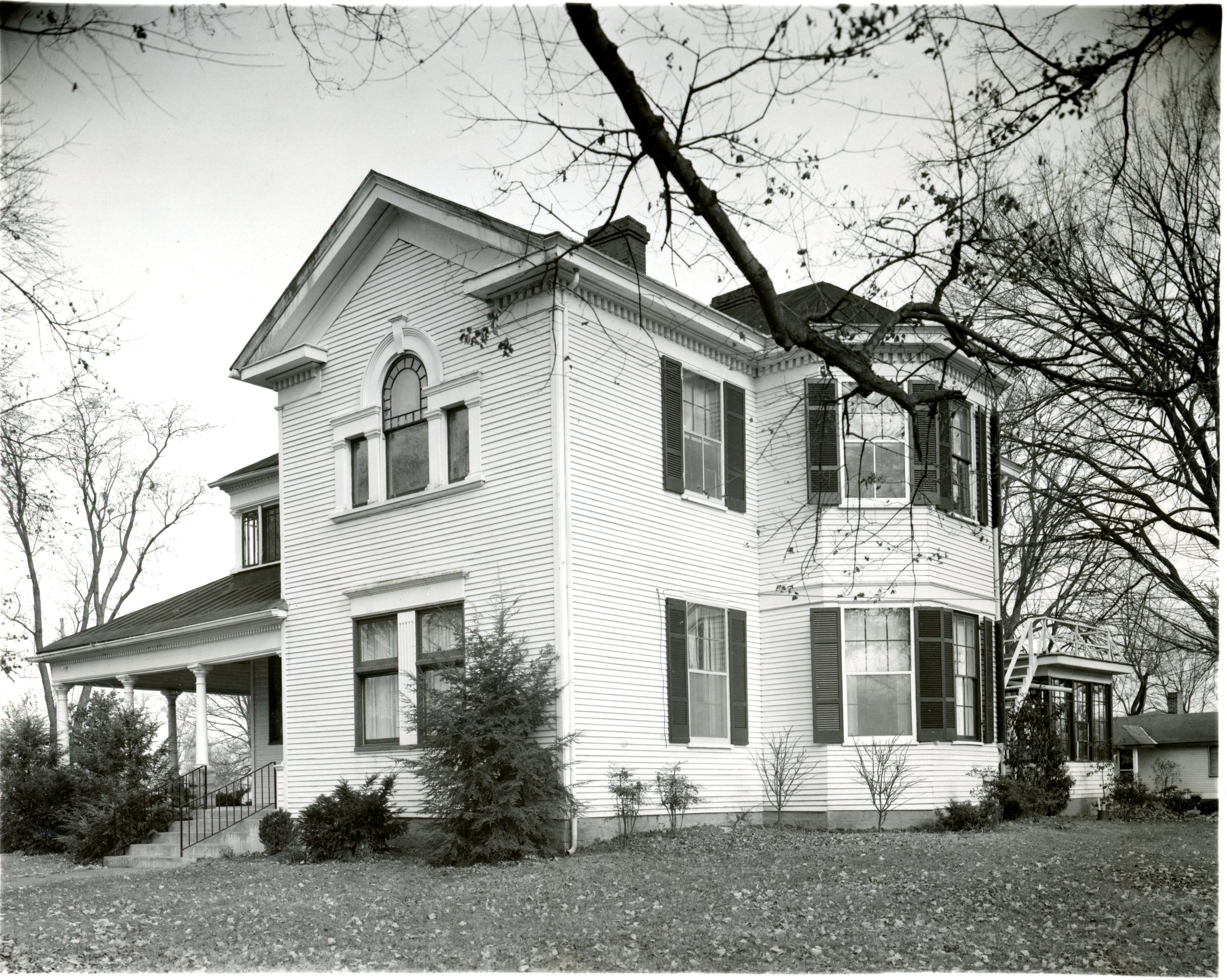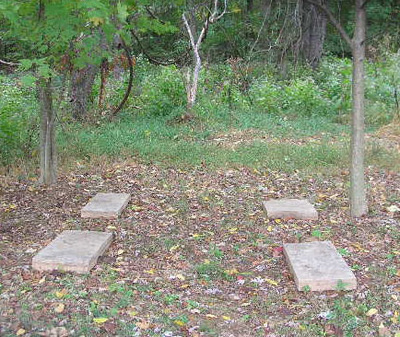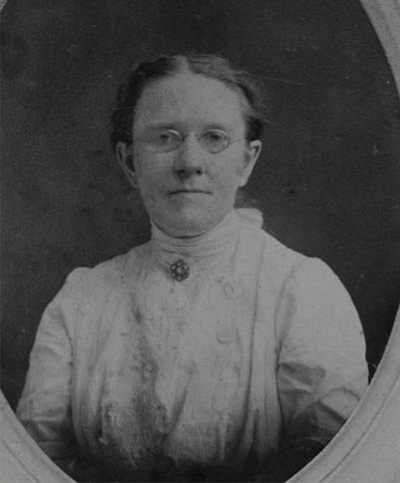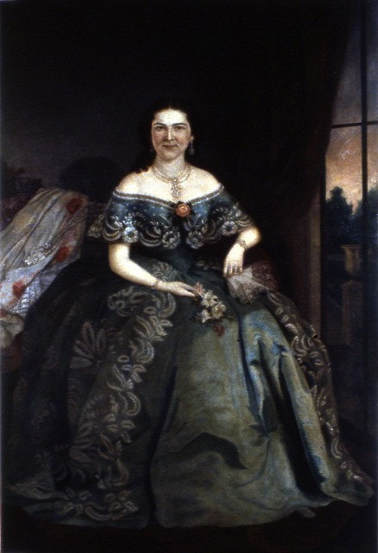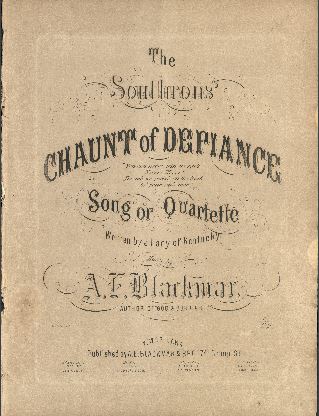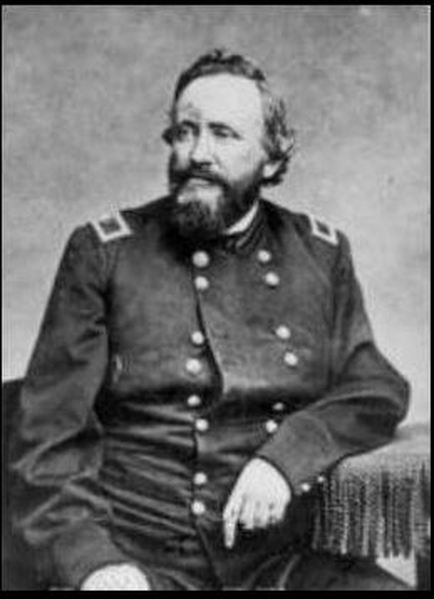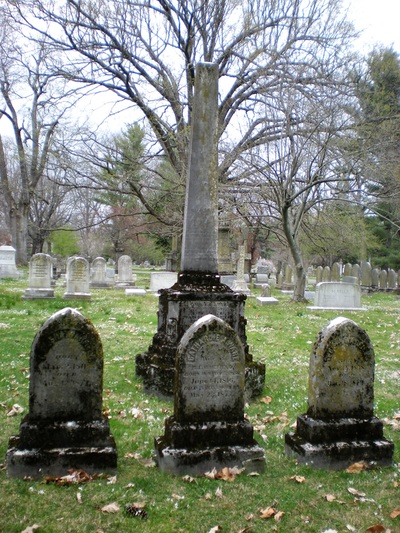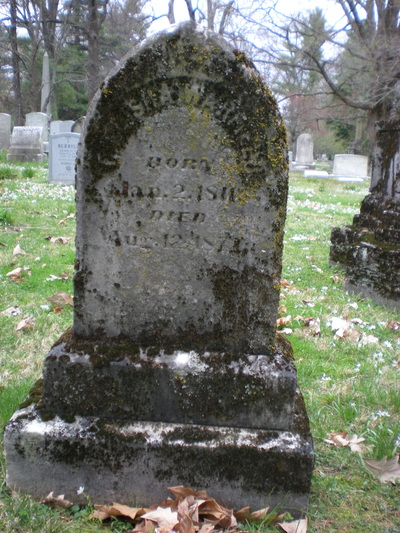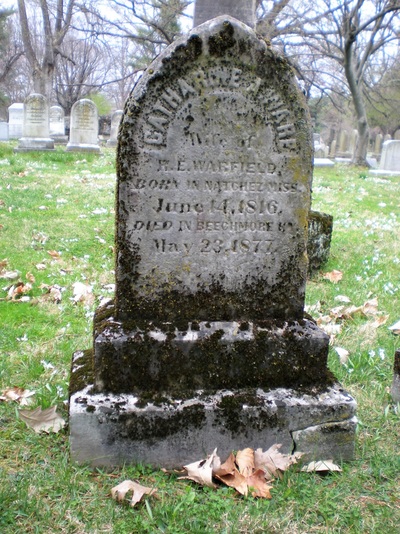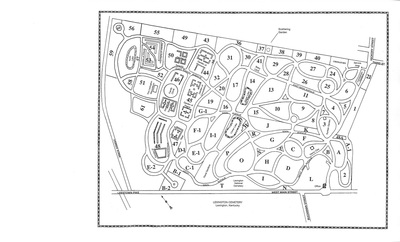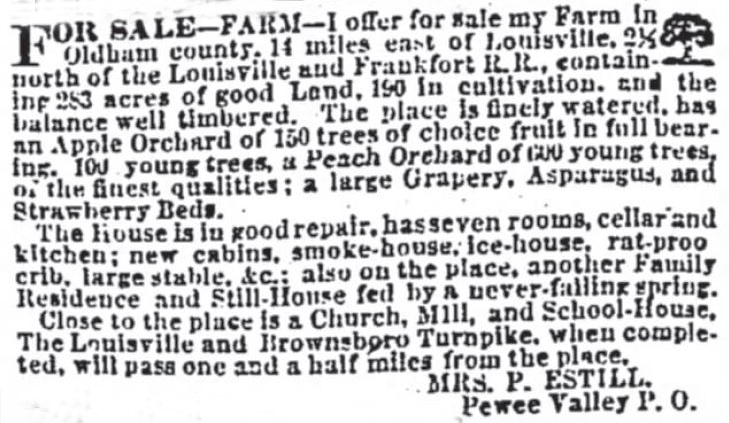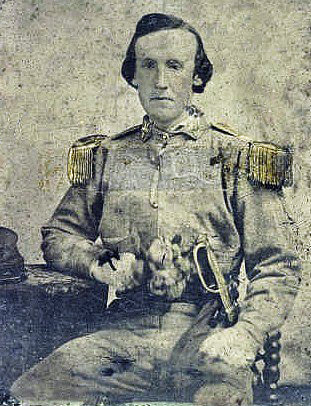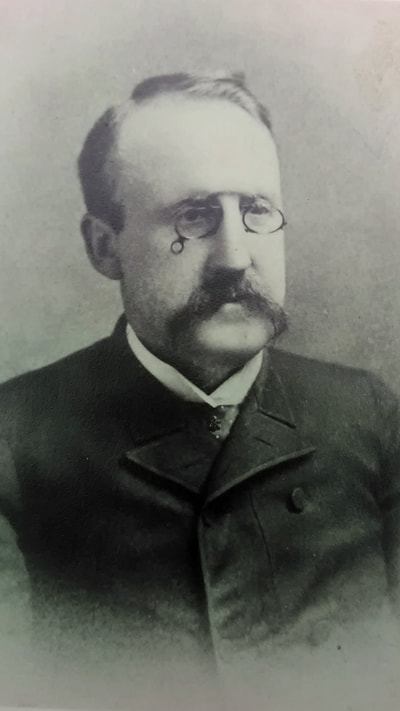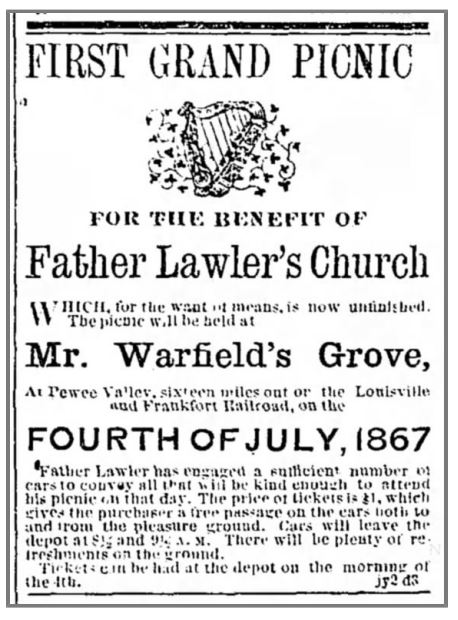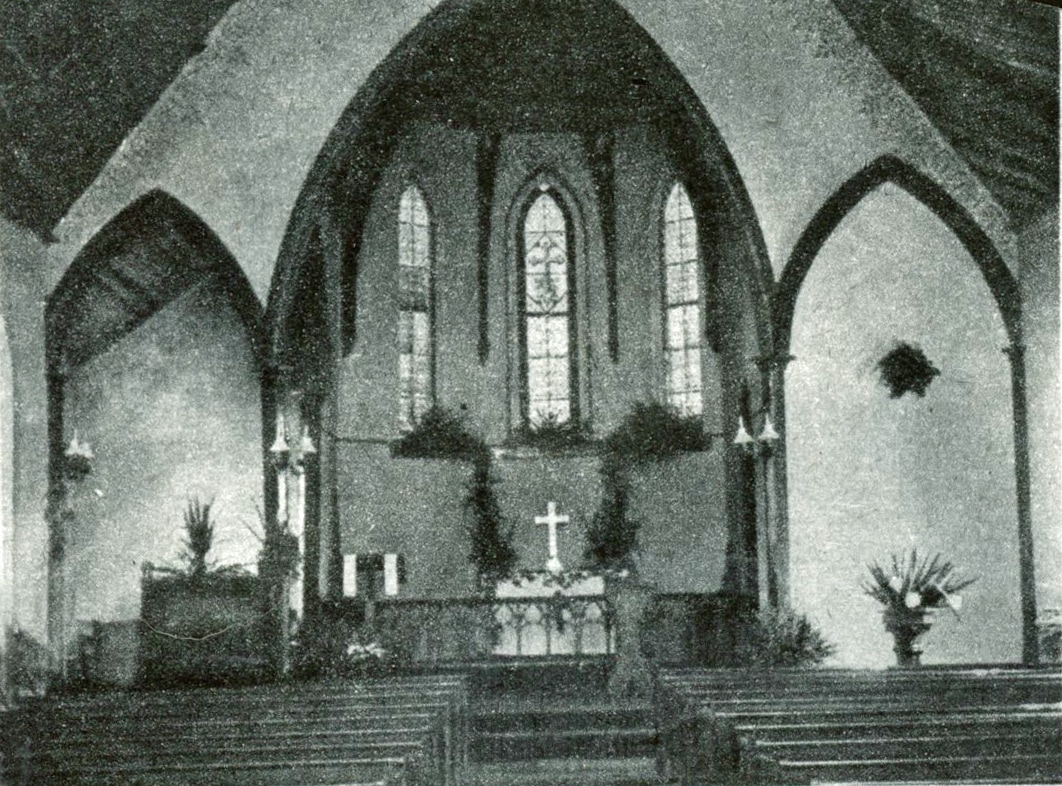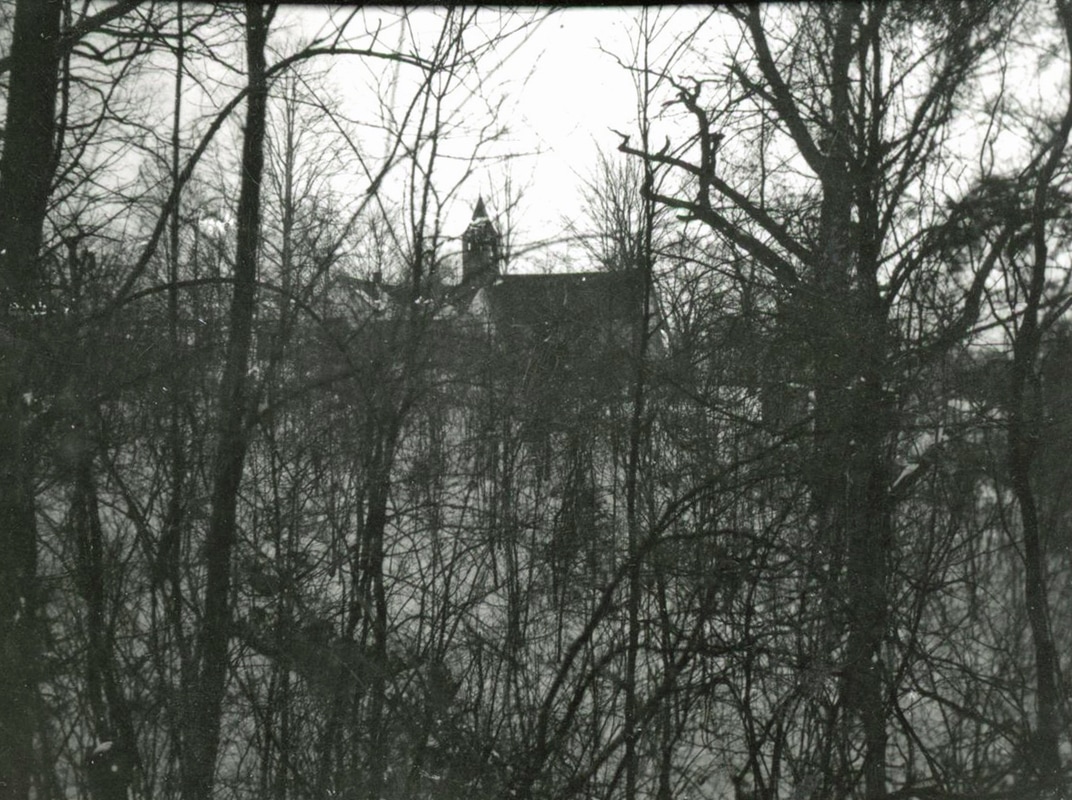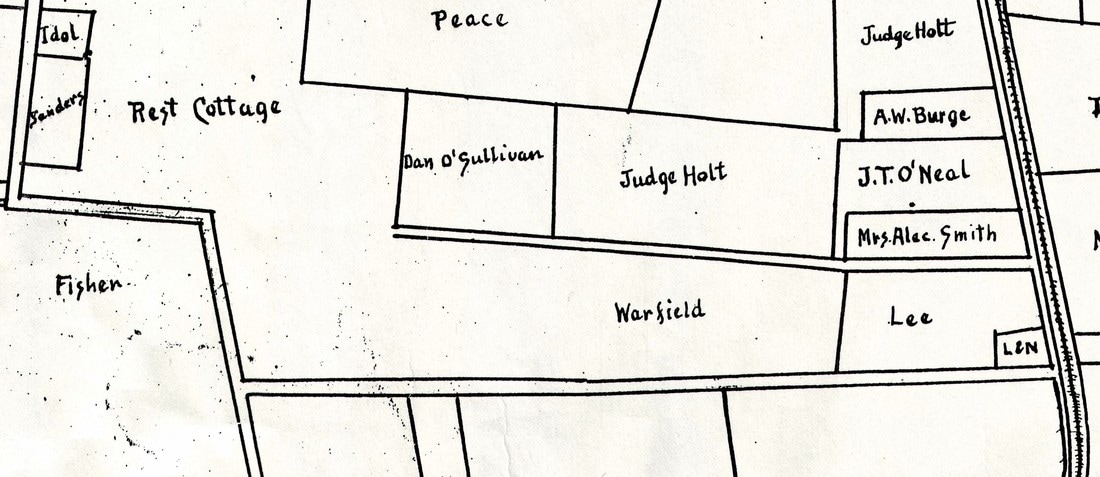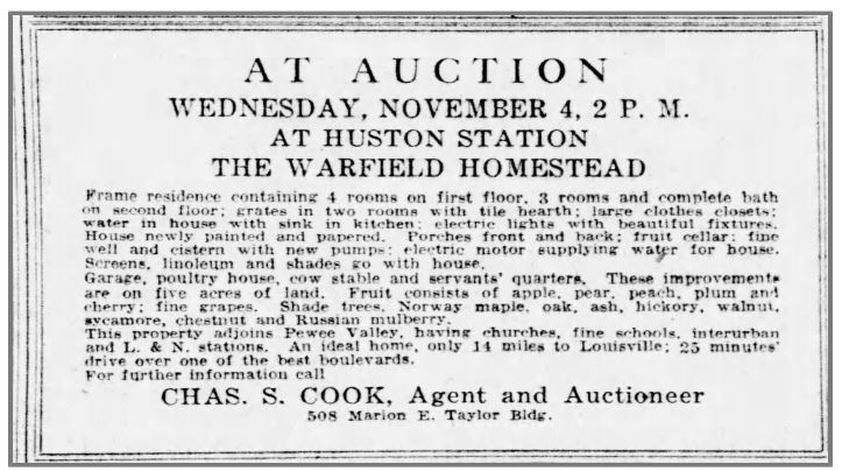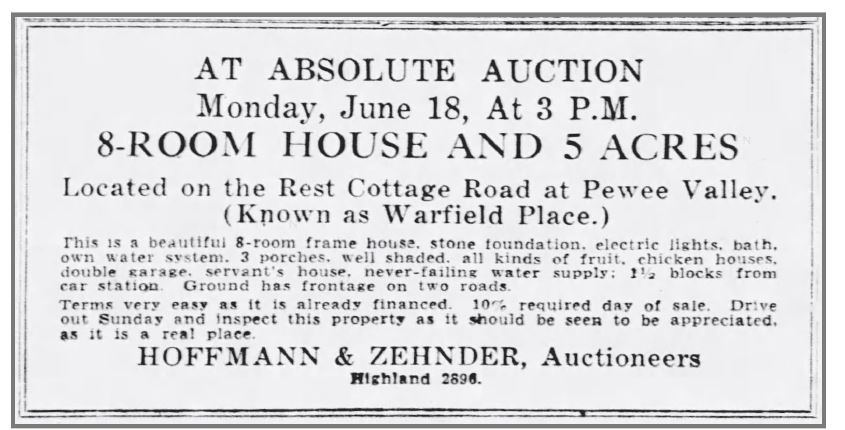Beechmore: The Southers and the Warfields
Among the many Pewee Valley landmarks featured on The Little Colonel Game Board is Beechmore, once located at the end of Rest Cottage Lane. Not only was the house – and the family who lived there in the 1880s and ‘90s – included in Annie Fellows Johnston’s very first Little Colonel story, it boasted one of the oldest and richest histories of any home in Pewee Valley. Sadly, it was demolished in 1998 and its 64-acre grounds are now the site of the Woods of Pewee Valley subdivision.
Origins: The Souther Years
neechmore was originally built around 1830 by Michael Souther (February 26, 1806 – December 29, 1859) and his wife, Catherine Clore (March 11, 1812-February 15, 1872). The two were married on September 21, 1830 in Oldham County.
Michael was the son of Henry and Anna Wilhoit Souther, who had come to the area in the 1820s from Virginia with eight children and 10 slaves. They settled where Tanglewood is located today. Catherine was the daughter of Solomon (November 17, 1776-August 27, 1814) and Rosanna Yager Clore (October 9, 1778-February 21, 1866), another family that came from Virginia to Kentucky. They had six children:
Michael and Catherine Clore Souther also had six children. Four of them died and were buried on their farm. They lost three in the space of a month, very possibly to typhoid, yellow fever or cholera, which had reached the Mississippi and Ohio River valleys via steamboat in 1849 and was epidemic along the country’s inland waterways through 1851. In St. Louis, 4,557 perished and in Cincinnati, 5,696. In Louisville, so many succumbed that the St. Boniface and St. Mary’s parishes founded the St. Josepth’s German Catholic Orphan Society to care for the many children who had lost their parents. That institution survives today as the St. Joseph Children’s Home.
Authors James Ramage and Andrea S. Watkins of Kentucky Rising, published by The University of Kentucky Press and The Kentucky Historical Society (The University of Kentucky Press: 2011), included this description of the cholera epidemics that hit the commonwealth starting in 1833:
…So many fatalities occurred so quickly and there was so much fear of dead bodies that bodies stacked up outside Lexington Cemetery, many dressed in nightclothes and gowns in which they expired. Workers dug long trenches for common graves…
…Asiatic cholera was caused by the bacterium Vibrio Comma, which spread on the unwashed hands of the infected, on uncooked fruits and vegetables handled by unwashed hands, and more significantly, in bowel discharges of infected patients that contaminated the water supply…symptoms began suddenly and without warning with diarrhea, vomiting, and severe cramping. Dehydration led to oxygen deficiency in the skin; the face turned blue, and the hands and feet puckered and felt cold. Some died within a few hours, and most who died expired within twenty-four to thirty-six hours – the death rate was about 50 percent….
Though the graveyard’s original location on the Beechmore tract has not been precisely determined, the children’s headstones survived and are now at Pewee Valley Cemetery:
Before Michael died in 1859, the couple had two more children:
Mary is buried with her parents in Floydsburg Cemetery. Only Ida survived to adulthood. She married Marcus Edmund Speer on April 22, 1869 in Oldham County and eventually settled in Owensboro, Kentucky.
Prior to Michael’s death in 1859, the Southers sold their farm to Catherine’s brother, Joseph Clore (1806-1887). The census shows that Catherine was widowed and residing in Brownsboro in 1870. Though Joseph had farmed and operated a saw mill in Pewee Valley for many years, in 1857, he moved to Henderson, Ky., where he went into the lumber trade full time. His business flourished and grew large enough to support him and his three sons: F. Lafayette, J.O. and W. Hall. He turned around and sold the “country seat” to the Warfields.
Michael was the son of Henry and Anna Wilhoit Souther, who had come to the area in the 1820s from Virginia with eight children and 10 slaves. They settled where Tanglewood is located today. Catherine was the daughter of Solomon (November 17, 1776-August 27, 1814) and Rosanna Yager Clore (October 9, 1778-February 21, 1866), another family that came from Virginia to Kentucky. They had six children:
- Wesley Clore (b. February 10, 1801 in Madison, Virginia; d. April 21, 1879 in Missouri)
- Matilda Clore (b. April 2, 1802 in Madison, Virginia; d. March 7, 1884)
- Susanna Clore (b. June 5, 1805 in Madison, Virginia; d. January 8, 1880)
- Joseph Clore (b. June 10, 1806 in Pewee Valley, Kentucky; d. March 24, 1887 in Henderson, Kentucky)
- Catherine Clore (b. March 11, 1812 in Pewee Valley, Kentucky; d. February 15, 1872 in Oldham County, Kentucky)
- Rebecca Clore (b. August 27, 1814; d. unknown)
Michael and Catherine Clore Souther also had six children. Four of them died and were buried on their farm. They lost three in the space of a month, very possibly to typhoid, yellow fever or cholera, which had reached the Mississippi and Ohio River valleys via steamboat in 1849 and was epidemic along the country’s inland waterways through 1851. In St. Louis, 4,557 perished and in Cincinnati, 5,696. In Louisville, so many succumbed that the St. Boniface and St. Mary’s parishes founded the St. Josepth’s German Catholic Orphan Society to care for the many children who had lost their parents. That institution survives today as the St. Joseph Children’s Home.
Authors James Ramage and Andrea S. Watkins of Kentucky Rising, published by The University of Kentucky Press and The Kentucky Historical Society (The University of Kentucky Press: 2011), included this description of the cholera epidemics that hit the commonwealth starting in 1833:
…So many fatalities occurred so quickly and there was so much fear of dead bodies that bodies stacked up outside Lexington Cemetery, many dressed in nightclothes and gowns in which they expired. Workers dug long trenches for common graves…
…Asiatic cholera was caused by the bacterium Vibrio Comma, which spread on the unwashed hands of the infected, on uncooked fruits and vegetables handled by unwashed hands, and more significantly, in bowel discharges of infected patients that contaminated the water supply…symptoms began suddenly and without warning with diarrhea, vomiting, and severe cramping. Dehydration led to oxygen deficiency in the skin; the face turned blue, and the hands and feet puckered and felt cold. Some died within a few hours, and most who died expired within twenty-four to thirty-six hours – the death rate was about 50 percent….
Though the graveyard’s original location on the Beechmore tract has not been precisely determined, the children’s headstones survived and are now at Pewee Valley Cemetery:
- Robert M. Souther (February 13, 1835- December 18, 1838)
- George Anna Souther (July 18, 1840-August 8, 1849)
- Guy Souther (June 26, 1837- August 21, 1849)
- William H. Souther (September 2, 1848 – September 9, 1849)
Before Michael died in 1859, the couple had two more children:
- Ida Michael (February 5, 1853 - ? ); and
- Mary C. (August 21, 1855 – October 21, 1860).
Mary is buried with her parents in Floydsburg Cemetery. Only Ida survived to adulthood. She married Marcus Edmund Speer on April 22, 1869 in Oldham County and eventually settled in Owensboro, Kentucky.
Prior to Michael’s death in 1859, the Southers sold their farm to Catherine’s brother, Joseph Clore (1806-1887). The census shows that Catherine was widowed and residing in Brownsboro in 1870. Though Joseph had farmed and operated a saw mill in Pewee Valley for many years, in 1857, he moved to Henderson, Ky., where he went into the lumber trade full time. His business flourished and grew large enough to support him and his three sons: F. Lafayette, J.O. and W. Hall. He turned around and sold the “country seat” to the Warfields.
The Warfield Years
Elisha Warfield's Family Background
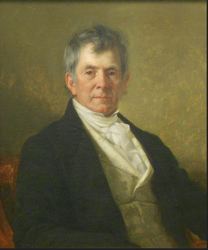 George P.A. Healy painted this oil portrait of Dr. Elisha Warfield, father of Robert Elisha Warfield who once lived at Beechmore. The portrait is on display in the Kentucky at Lexington Public Library.
George P.A. Healy painted this oil portrait of Dr. Elisha Warfield, father of Robert Elisha Warfield who once lived at Beechmore. The portrait is on display in the Kentucky at Lexington Public Library.
Robert Elisha Warfield, Jr. (January 2, 1811- August 15, 1872), known as Elisha, and his wife, Catharine Anne Ware (June 6, 1816- May 21,1877), were an aristocratic pair and part of the wave of literati who arrived in Pewee Valley after the Louisville and Frankfort Railroad was completed.
Elisha came from a prominent Lexington family. His father, Dr. Elisha Warfield, had come to Kentucky from Maryland with his family at age nine. He received his degree in medicine from Transylvania University, where he became a professor of surgery and obstetrics. He married Maria Barr on January 15, 1805 and they raised 10 children on their Lexington stud farm, The Meadows:
- Rebecca Tilton Warfield, b. January 02, 1806
- Thomas Barr Warfield, b. September 14, 1807, Fayette County, Kentucky
- William Pollack Warfield, b. February 26, 1809
- Robert Elisha Warfield, b. January 02, 1811-1872
- Ann Elizabeth Warfield, b. November 17, 1812
- Mary Jane Warfield, b. January 20, 1815, Lexington, Fayette County, Kentucky. She was the wife of Cassius Marcellus Clay (October 19, 1810 – July 22, 1903), "The Lion of White Hall", who was a Kentucky planter and politician who worked for abolition of slavery.
- Ellen P. Warfield
- Julia Warfield
- Caroline Barr Warfield, b. January 15, 1817
- Julia Genevieve Warfield, b. July 07, 1819
- Laura Ruth Warfield, b. March 12, 1821
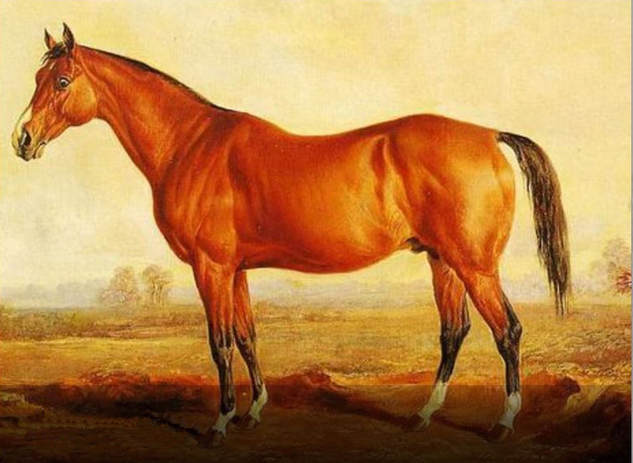 Portrait of Lexington, the thoroughbred that earned Dr. Elisha Warfield the title, "Father of Kentucky Turf."
Portrait of Lexington, the thoroughbred that earned Dr. Elisha Warfield the title, "Father of Kentucky Turf."
Elisha’s father was a Lexington upbuilder. He was a founding shareholder in the Lexington & Ohio Railway Company that connected Lexington with the state capital in 1834, and he and his brother, attorney Benjamin Warfield, were also charter members of Lexington Cemetery. However, it is for his contributions to the Bluegrass State’s thoroughbred racing industry that Dr. Elisha Warfield is remembered today.
In 1809, he became a founding member of the Lexington Jockey Club. By 1821, he had quit medicine entirely and was raising and racing thoroughbreds full time. His greatest success occurred on March 19, 1850, when the colt Darley – later renamed Lexington – was foaled at The Meadows. Enshrined today in the U.S. Race Horse Hall of Fame, Lexington still ranks among the all-time greatest breeding stallions in the U.S. Between 1861 and 1878, he was North America’s leading sire 14 times and helped earn the physician the moniker, “Father of Kentucky Turf.”
In 1809, he became a founding member of the Lexington Jockey Club. By 1821, he had quit medicine entirely and was raising and racing thoroughbreds full time. His greatest success occurred on March 19, 1850, when the colt Darley – later renamed Lexington – was foaled at The Meadows. Enshrined today in the U.S. Race Horse Hall of Fame, Lexington still ranks among the all-time greatest breeding stallions in the U.S. Between 1861 and 1878, he was North America’s leading sire 14 times and helped earn the physician the moniker, “Father of Kentucky Turf.”
Catharine Ware Warfield's Family Background
Catharine Anne Ware also enjoyed a privileged upbringing, though less happy than her husband’s. She was the older of two daughters born to Nathaniel and Sarah Percy Ellis Ware of Natchez, Mississippi. Sarah was a wealthy widow and already had several children by her first marriage when she married Nathaniel in 1814. In 1816, she gave birth to the couple’s first girl, Catharine, and four years later, Eleanor (1820-1849) was born. After Eleanor’s birth, Sarah developed childbirth fever, followed by postpartum depression. She never recovered from “melancholia,” and her husband took her to Philadelphia Hospital -- one of only two hospitals in the country at the time that cared for the mentally ill – where she spent the next decade of her life.
Catharine Anne Ware also enjoyed a privileged upbringing, though less happy than her husband’s. She was the older of two daughters born to Nathaniel and Sarah Percy Ellis Ware of Natchez, Mississippi. Sarah was a wealthy widow and already had several children by her first marriage when she married Nathaniel in 1814. In 1816, she gave birth to the couple’s first girl, Catharine, and four years later, Eleanor (1820-1849) was born. After Eleanor’s birth, Sarah developed childbirth fever, followed by postpartum depression. She never recovered from “melancholia,” and her husband took her to Philadelphia Hospital -- one of only two hospitals in the country at the time that cared for the mentally ill – where she spent the next decade of her life.
|
Her insanity dashed Nathaniel’s political aspirations in Mississippi and to escape his disappointing marriage, he travelled. He rented an apartment in Philadelphia, but spent much of his time away. He explored the upper gulf coast of Florida with the East Florida Coffee Land Association, went to Europe, speculated in land in Arkansas, Texas and Mississippi, and invested in a number of businesses. He also accompanied Abdul Rahman, an African prince, who served for 40 years as a slave on a Mississippi plantation, on his tour of North America in 1828. Sometimes, his daughters accompanied him on his trips, but they spent much of their time in the care of a nurse and English governess and learned to rely on each other for companionship.
According to “The House of Percy: Honor, Melancholy, and Imagination in a Southern Family” by Bertram Wyatt-Brown (New York: Oxford University Press, 1996), in many ways the sisters were opposites. While Catherine was shy, with a preference for home tutoring and reading books from her father’s extensive library, Eleanor enjoyed society and attended Madam Sigoigne’s fashionable school for young ladies, where she learned to speak French fluently with other Philadelphia bluebloods. Eleanor was blue-eyed, blonde and pretty, like their father, while Catharine – or “Kitty” as her sister called her – considered herself plain and inherited her mother’s blue-black hair and gray eyes. |
Marriage and Children
Catharine was only 16 when she married Elisha Warfield on January 3, 1833 in Cincinnati. The Ware family had moved there in 1831, after Nathaniel removed Sarah from the Philadelphia Hospital and sent her to live out the remainder of her years at the Mississippi plantation home of her son by her first marriage, Thomas George Ellis.
Wyatt-Brown described Elisha as a “tolerant, well-born” gentleman “with little ambition or talent,” although he shared his father’s interest in horses. His father-in-law considered him something of a ne’er-do-well and never let him touch Catharine’s dowry – worth in excess of $100,000 in 1836 -- during his lifetime. Evidently, Elisha never proved himself “trustworthy and confidential” or “worthy of the responsibilities” – Nathaniel Ware’s conditions for allowing him to control his daughter’s estate.
The couple enjoyed an extended honeymoon in France, where their first child, Nathaniel, was born. They eventually settled down in Elisha’s hometown, Lexington, Ky., where Catharine was considered “one of the chief ornaments of the wealthy, refined, and intellectual circles of that section of Kentucky,” according to William T. Coggeshall in “Poets and Poetry of the West: With Biographical Sketches and Critical Notices,” (Columbus: Follett, Foster and Company, 1860).
In 1840, Eleanor married Henry William Lee, a cousin of Robert E. Lee. Four years later, the young women published their first book of poetry together, “The Wife of Leon, and Other Poems, by Two Sisters of the West,” followed by a second volume in 1846 called, “The Indian Chamber, and Other Poems.” After Eleanor died suddenly of yellow fever in 1849, however, Catharine quit writing for many years and concentrated on raising her six childen:
- Nathaniel Ware Warfield, (April 23, 1834- December 1908) married Alice Estill (1839-1926) on May 21, 1860
- Eleanor P. Warfield Bell (January 21, 1837-April 2, 1901)
- Thomas Percy Warfield, b. November 12, 1838
- Mary Ross Warfield Clemens, (April 4, 1842-December 12, 1870)
- Catherine “Kitty” Sarah Warfield Bell Munce (1844-?) married Henry Bell, Jr. of St. Louis on March 27, 1866, married second Captain Thomas Quitman Munce, who served in the Confederate Army during the Civil War, on May 23, 1873 in St. Louis, Missouri
- Lloyd Elisha Warfield, b. 1846 married Annie LaRoche on December 1, 1874
Move to Pewee Valley
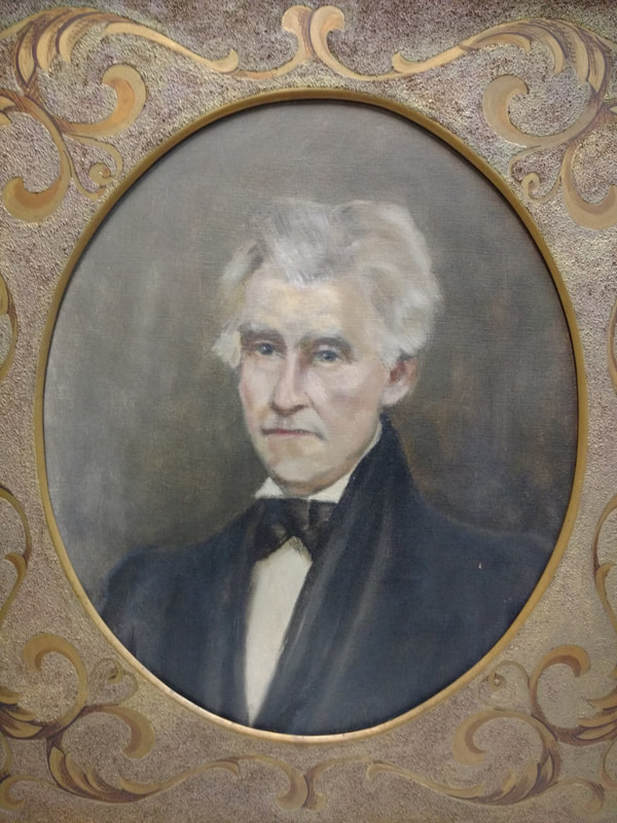 Judge Benjamin Estill had been dead for seven years by the time Nathaniel Warfield married his daughter, Alice. Portrait courtesy of Martha Wiley with the Southwest Virginia Museum Historical State Park.
Judge Benjamin Estill had been dead for seven years by the time Nathaniel Warfield married his daughter, Alice. Portrait courtesy of Martha Wiley with the Southwest Virginia Museum Historical State Park.
In 1857, reduced financial circumstances impelled the Warfields to leave Lexington and move to “Beechmoor” in Pewee Valley, where in 1860, Coggeshall noted, they were, “dispensing the charms of a refined and liberal hospitality to an attached circle of artists, poets, editors, and other persons of culture. Among her immediate neighbors (were) Edwin Bryant, one of the earliest American emigrants to California, and the first Alcalde of San Francisco; Noble Butler, the accomplished scholar, critic, grammarian, and teacher; William D. Gallagher, and others of like tastes, cultivation, and pursuits.” Also among their neighbors was Thomas Smith, who, like Elisha, had invested in the Louisville and Frankfort railroad that was ultimately responsible for putting Pewee Valley on the map.
Three of the Warfield’s children were living with them in 1860, according to the census: Mary, 18; Catherine, 16; and Lloyd, 13. Nathaniel, their oldest, had married Alice Estill, daughter of Patsy Estill and the late Virginia legislator, Congressman and Fifteenth Judicial Circuit Judge Benjamin Estill on May 31st of that year. The Estills had moved to Pewee Vally in 1852, when the judge retired. He died the following year.
Three of the Warfield’s children were living with them in 1860, according to the census: Mary, 18; Catherine, 16; and Lloyd, 13. Nathaniel, their oldest, had married Alice Estill, daughter of Patsy Estill and the late Virginia legislator, Congressman and Fifteenth Judicial Circuit Judge Benjamin Estill on May 31st of that year. The Estills had moved to Pewee Vally in 1852, when the judge retired. He died the following year.
Literary Career and Civil War
|
At the urging of a niece – and perhaps because she was surrounded by so many authors and journalists in Pewee Valley -- Catharine started writing again and began publishing poems in the Louisville Journal. In 1860, her first novel, “The Household of Bouverie,” debuted anonymously to widespread critical acclaim. During the Civil War, she wrote poems in support of the Confederacy. One of her most famous works, a violently pro-South ditty called "The Southrons Chaunt," or "You Can Never Win Us Back," was set to music by A.E. Blackmar and published by his New Orleans company in 1861: You can never win them back, never, never; Though they perish on the track of your endeavor; Though their corpses strew the earth That smiled upon their birth, And blood pollutes the hearth -stone forever. They have risen to a man stern and fearless; Of your curses and your ban they are careless. Every hand is on its knife; Every gun is primed for strife. Every palm contains a life high and peerless. You have no such blood of theirs for the shedding; In the veins of Cavaliers was its heading. You have no such stately men In your abolition den, To march through foe and fen nothing dreading. They may fall before the fire from your legions, Paid in gold for murd'rous hire -- bought allegiance; But for every drop you shed You shall leave a mound of dead; And the vultures will be fed in our regions. But the battle to the strong is not given, While the judge of right and wrong sits in heaven. And the God of David still Guides each pebble by his will. There are giants yet to kill -- wrongs unshriven. She wrote another about the battle of Manassas: They have met at last — as storm-clouds Meet in heaven, And the Northmen back and bleeding Have been driven; And their thunders have been stilled, And their leaders crushed or killed, And their ranks with terror thrilled, Rent and riven! Like the leaves of Valambrosa, They are lying; In the moonlight, in the midnight, Dead and dying; Like the leaves before the gale, Swept their legions, wild and pale; While the host that made them quail Stood, defying. When aloft in morning sunlight Flags were flaunted, And "swift vengeance on the rebel" Proudly vaunted: Little did they think that night Should close upon their shameful flight. And rebels, victors in the fight, Stand undaunted. But peace to those who perished In our passes! Light the earth above them; Green the grasses! Long shall Northmen rue the day When they met our stern array, And shrunk from battle's wild affray At Manassas. |
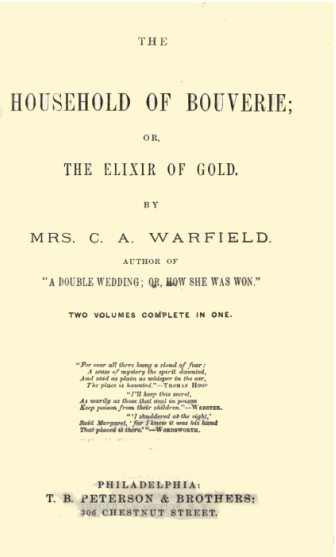
A copy of Catharine Warfield's bestselling first novel is on display at the Pewee Valley Museum.
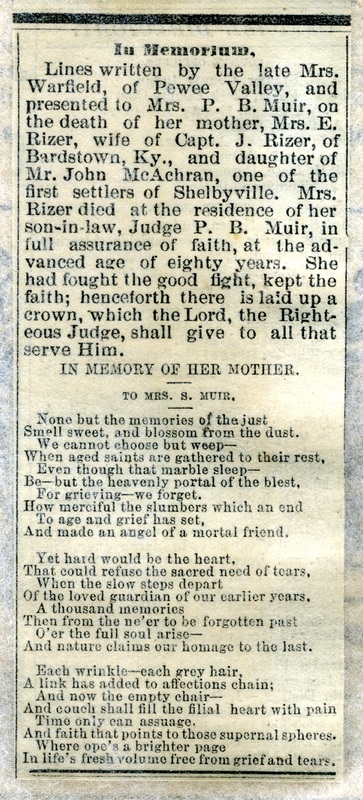
Courtesy of the Dick family, descendants of Judge Peter B. Muir and Hattie Cochran Dick
|
On July 9, 1877, the Oldham Era published a story called, "Pewee Valley -- Its Surroundings -- Reminiscences of Its Pioneers" written by Mrs. E.W. Mason, nee Mary Shallcross. In it, she talked about her friendship with Catharine Warfield and their common support of the Confederacy:
... The kindly feelings (between us) were cemented by sympathy as we were both called by General Boyle (editor's note: Jeremiah Tilford Boyle, Union military commander) dangerous rebels (it being during the war). On one occasion we determined to make an attempt to visit the then called rebel camp at Simpsonville, in hopes of meeting friends, but failed, and as a reward we saw the gentlemen who were our escorts thrown into military prison, and ourselves branded as feminine traitors. But women's tact seldom fails, and after appearing before the authorities we received from the General himself a permit to have our friends released, not withstanding one of the officers captured a note which Mrs. Warfield had written to her husband and sandwiched in a biscuit for safe and secure delivery,,,
After the war, Catharine returned to prose and penned nine more novels:
- The Romance of the Green Seal (1867)
- Miriam Monfort (1873)
- A Double Wedding (1875)
- Hester Howard's Temptation (1875)
- Lady Ernestine (1876)
- Miriam's Memoirs (1876)
- Sea and Shore (1876)
- Feme Fleming (1877)
- The Cardinal's Daughter (1877).
Her last two, "Feme Bleming" and "The Cardinal's Daughter," were written the year she died.
Catharine also wrote poems for her friends and neighbors in Pewee Valley, including one telling the story of how Pewee Valley came by its unusual name.
Deaths of Elisha and Catharine
By the 1870 census, only one of Catharine’s and Elisha’s children, their widowed daughter, Mary Ross Warfield Clemens, and her two children, Lily and James, were living with them at Beechmore. Mary died that year. Elisha died in 1872 and Catharine in 1877. They were buried in Lexington Cemetery. Their wills, courtesy of Oldham County Clerk Julie Barr, are below:
In the Name of God Amen knowing the uncertainty of Life, I, Elisha Warfield of the County of Oldham State of Kentucky, doth this 4th day of August 1871 in the City of Louisville publish this as my last Will and testament abolishing all other wills. I will and bequeath to my Daughter Mrs. Kittie Bell all the property devised to me in trust by my Mother. If Mrs. Kitty Bell be married than I devise all the aforesaid property to my son L. (Lloyd ) Warfield . My Mother’s will precludes me bearing her devise to me in a way that I would much desire to my dearly beloved wife. I therefore request my devise to pay to their Mother the whole property after paying to each of my Children $1000 One Thousand Dollars as an evidence of my love and affection for them. If Mrs. Kittie Bell be still a widow and of conservance the devise of this wish she will of her own right retain one Half of this Estate afer paying over to each of my Children One Thousand Dollars $1000. The other half she will pay over to her Mother in fee simple that there may be no mistake in this matter I wish my Children to distinctly to understand I wish the whole of this payment to go to their Mother if Kittie is married and if she be still a widow one Half to go to Kittie the other half to their mother without instruction of any kind after paying to the other devise the One Thousand Dollars. Done in the City of Lousiville the 4th day of August 1871. - E. Warfield
The Warfield Graves in Lexington Cemetery, Lexington, Ky.
Catharine’s will includes many details about Beechmore’s furnishings, as well as a few glimpses of her daily life in Pewee Valley.
February 28, 1877
I Catharine A. Warfield sound in mind but infirm in body and with an uncertain tenure of life do declare this to be my only will and testament.
I desire that my place Beechmore be perserved in its integrity until the mortgage becomes due – three years from next May and that my sons Nathaniel and Lloyd Warfield with their families all occupy it jointly until such time – with equal privileges or certain conditions, being that the semi-annual interest of $100 due to Roe and Lyon on mortage be paid by them in equal shares – They are recommended to employ the Buckners as present tenants until the three years expire as well as the county and corporation tax on said property. If one refuses this offer – then it shall be considered to devolve on the other brother to carry out my intentions but if both reject the request, the house and land afforded, where in their poverty then shall the same offer be made to Mrs. Kitty Munce and if she also declares then shall the property be sold to the highest bidder at such time as Judge Muir may deem fitting and proceeds divided evenly after sale to take place when the mortgage becomes due under any circumstances with same division of proceeds between Lloyd and Kitty only after debts and legacies are paid as mentioned after the payment of my debts between Lloyd Warfield and Kitty Munce his sister – with the exception of a legacy of $500 (five hunded dollars) to my grand daughter Hetta Warfield to be paid to her for her own use only on her eighteenth birthday by Judge Muir who is requested to see the provisions of this will properly executed and to deduct his account from the result of sale should my sons one or both see fit to occupy the mansion the furniture is to remain intact with some small exceptions until the mortgage becomes due when it is to be divided according to my bequest as follows. I leave the parlor furniture as it stands to Catherine Sarah or Kitty Munce except books & bookshelves for Lilly Clemens the furniture of the spare room above the parlor to my granddaughter Hetta Warfield and also 1 bookcase – full of books that is next to the front window in the dining room with all the books it contains. I leave my mahogany bookcase in the recess by fireplace to my son Lloyd with the books it contains and that opposite to my daughter Eleanor P. Bell with all it contains knowing that she will like to possess her grandfather’s books. I also leave to her my 12 large table forks and ladle china silver and books to be distributed immediately after death and my gold chain and basket and to Kitty Munce all my decorated china and cut glass and wine small glasses. To my daughter in law I leave jointly my spoons and house wares and with all the remainder of my household effects with some small exceptions box in upper shelf of wardrobe to Lilly Clemens I leave to Rose Lindsay my small dining table with folding leaves and little maple topped dressing stand the one I habitually use as well as a suit of black from my dresses to be selected by Mrs. E. P. Bell for her and a shawl with a request that she wear them as mourning.
To my old servant Annatto I leave my bombarquit dress trimmed with crape, my bonnet and shawl to match my wadded cape and cloak with the request she will wear these as mourning.
I leave my French clock in my room to Mrs. Birdie Guy. Also the candlesticks and branches on my mantle piece and 1 plated coffee pot from any set. I leave my plated silver salvers and branches and slubs on my mantle piece in the dining room to my grand daughter Clara Bell as ancient relics knowing she will prize them as such.
I leave my trunk of dresses in the closet under the stairs to my granddaughter Hetta Warfield with the exception of one _____ lace set of her mother’s to Lilly which will be found in my fan box in my trunk to be kept for her until her 18th birthday though if in need of them she may use them earlier. not to be sold.
I leave my trunk of summer clothes chemises gowns etc. to be divided among my children and servants as Mrs. Eleanor Bell may see fit. To Lucinda Buckner a pr. of blankets, a bedspread and 2 wrappers to be selected by my daughter Eleanor for her use and to Hetta Warfield two prs. linen sheets, two bolstercases and a pr. of lace trimmed pillowslips and 1 pr. new blankets and my red satin comforter to be reserved for her own use.
To Mrs. Estill (editor's note: Patsy Estill was her son Nathaniel's mother-in-law and a neighbor) my Eiderdown quilt wadded petticoat black print and large sofa upstairs. My new black silk dress to my daughter Kitty as mourning also my black crepe veil I beg my children to wear mourning for me but one year and the legacies to be used for six months.
I request my daughter Eleanor to see that I am buried near my husband and to have simple headstones placed at the three graves in the Lexington Cemetery with names and dates only. I desire to have the three graves sodded and surrounded with stone coping to keep them from becoming flat.
After this I believe I have nothing more to leave except my blessing and earnest hope that my descendents may lead suitable lives.
Catharine A. Warfield
Codicil
If anything comes from the Texas property (editor’s note: property she inherited from her father and gave to her “feckless son” Nathaniel to manage; it was known as the San Jacinto tract and was in Galveston) let it be divided equally between my four children. Eleanor Bell will please give to Dr. Foree Judge Muir and M.C. Johnson of Lexington for one seal ring to the value of $50 each. My amethyst ring is for my son Lloyd my diamond ring for my daughter Eleanor. Bury me with my wedding ring and in a white gown and cap such as I wear habitually with a chin support of tartetege and spread over me a long veil either of dark or grave black which must not be lifted by anyone when I am once placed in my coffin. Lay a fine handkerchief over my breast and put white thread gloves on my hands. Let my coffin be of moderate expense and funeral private. I leave my secretary and its contents to my daughter Eleanor P. Bell as well as the copywright of my poems, all I have left.
26 Feby.
Catharine A. Warfield
Codicil (2nd) Feby. 27th 1877
Judge Muir my Executor is requested to pay to Dr. Foree $200 for me partly owed for money borrowed partly on medical account and to present him with a set of books from my library merely in remembrance of our friendship to be chosen from either bookcase before their contents are divided.
This is my last instruction. I want my daughter Eleanor to take my wardrobe at any time she chooses from the household effects for her own use and anything else she fancies was not something to ???? the furniture of the mansion. I hope my daughter Kitty will keep my furniture and not sell it. The satin curtains in the trunk and the chairs are to be given to her to dye and recover the parlour furniture.
February 28, 1877
I Catharine A. Warfield sound in mind but infirm in body and with an uncertain tenure of life do declare this to be my only will and testament.
I desire that my place Beechmore be perserved in its integrity until the mortgage becomes due – three years from next May and that my sons Nathaniel and Lloyd Warfield with their families all occupy it jointly until such time – with equal privileges or certain conditions, being that the semi-annual interest of $100 due to Roe and Lyon on mortage be paid by them in equal shares – They are recommended to employ the Buckners as present tenants until the three years expire as well as the county and corporation tax on said property. If one refuses this offer – then it shall be considered to devolve on the other brother to carry out my intentions but if both reject the request, the house and land afforded, where in their poverty then shall the same offer be made to Mrs. Kitty Munce and if she also declares then shall the property be sold to the highest bidder at such time as Judge Muir may deem fitting and proceeds divided evenly after sale to take place when the mortgage becomes due under any circumstances with same division of proceeds between Lloyd and Kitty only after debts and legacies are paid as mentioned after the payment of my debts between Lloyd Warfield and Kitty Munce his sister – with the exception of a legacy of $500 (five hunded dollars) to my grand daughter Hetta Warfield to be paid to her for her own use only on her eighteenth birthday by Judge Muir who is requested to see the provisions of this will properly executed and to deduct his account from the result of sale should my sons one or both see fit to occupy the mansion the furniture is to remain intact with some small exceptions until the mortgage becomes due when it is to be divided according to my bequest as follows. I leave the parlor furniture as it stands to Catherine Sarah or Kitty Munce except books & bookshelves for Lilly Clemens the furniture of the spare room above the parlor to my granddaughter Hetta Warfield and also 1 bookcase – full of books that is next to the front window in the dining room with all the books it contains. I leave my mahogany bookcase in the recess by fireplace to my son Lloyd with the books it contains and that opposite to my daughter Eleanor P. Bell with all it contains knowing that she will like to possess her grandfather’s books. I also leave to her my 12 large table forks and ladle china silver and books to be distributed immediately after death and my gold chain and basket and to Kitty Munce all my decorated china and cut glass and wine small glasses. To my daughter in law I leave jointly my spoons and house wares and with all the remainder of my household effects with some small exceptions box in upper shelf of wardrobe to Lilly Clemens I leave to Rose Lindsay my small dining table with folding leaves and little maple topped dressing stand the one I habitually use as well as a suit of black from my dresses to be selected by Mrs. E. P. Bell for her and a shawl with a request that she wear them as mourning.
To my old servant Annatto I leave my bombarquit dress trimmed with crape, my bonnet and shawl to match my wadded cape and cloak with the request she will wear these as mourning.
I leave my French clock in my room to Mrs. Birdie Guy. Also the candlesticks and branches on my mantle piece and 1 plated coffee pot from any set. I leave my plated silver salvers and branches and slubs on my mantle piece in the dining room to my grand daughter Clara Bell as ancient relics knowing she will prize them as such.
I leave my trunk of dresses in the closet under the stairs to my granddaughter Hetta Warfield with the exception of one _____ lace set of her mother’s to Lilly which will be found in my fan box in my trunk to be kept for her until her 18th birthday though if in need of them she may use them earlier. not to be sold.
I leave my trunk of summer clothes chemises gowns etc. to be divided among my children and servants as Mrs. Eleanor Bell may see fit. To Lucinda Buckner a pr. of blankets, a bedspread and 2 wrappers to be selected by my daughter Eleanor for her use and to Hetta Warfield two prs. linen sheets, two bolstercases and a pr. of lace trimmed pillowslips and 1 pr. new blankets and my red satin comforter to be reserved for her own use.
To Mrs. Estill (editor's note: Patsy Estill was her son Nathaniel's mother-in-law and a neighbor) my Eiderdown quilt wadded petticoat black print and large sofa upstairs. My new black silk dress to my daughter Kitty as mourning also my black crepe veil I beg my children to wear mourning for me but one year and the legacies to be used for six months.
I request my daughter Eleanor to see that I am buried near my husband and to have simple headstones placed at the three graves in the Lexington Cemetery with names and dates only. I desire to have the three graves sodded and surrounded with stone coping to keep them from becoming flat.
After this I believe I have nothing more to leave except my blessing and earnest hope that my descendents may lead suitable lives.
Catharine A. Warfield
Codicil
If anything comes from the Texas property (editor’s note: property she inherited from her father and gave to her “feckless son” Nathaniel to manage; it was known as the San Jacinto tract and was in Galveston) let it be divided equally between my four children. Eleanor Bell will please give to Dr. Foree Judge Muir and M.C. Johnson of Lexington for one seal ring to the value of $50 each. My amethyst ring is for my son Lloyd my diamond ring for my daughter Eleanor. Bury me with my wedding ring and in a white gown and cap such as I wear habitually with a chin support of tartetege and spread over me a long veil either of dark or grave black which must not be lifted by anyone when I am once placed in my coffin. Lay a fine handkerchief over my breast and put white thread gloves on my hands. Let my coffin be of moderate expense and funeral private. I leave my secretary and its contents to my daughter Eleanor P. Bell as well as the copywright of my poems, all I have left.
26 Feby.
Catharine A. Warfield
Codicil (2nd) Feby. 27th 1877
Judge Muir my Executor is requested to pay to Dr. Foree $200 for me partly owed for money borrowed partly on medical account and to present him with a set of books from my library merely in remembrance of our friendship to be chosen from either bookcase before their contents are divided.
This is my last instruction. I want my daughter Eleanor to take my wardrobe at any time she chooses from the household effects for her own use and anything else she fancies was not something to ???? the furniture of the mansion. I hope my daughter Kitty will keep my furniture and not sell it. The satin curtains in the trunk and the chairs are to be given to her to dye and recover the parlour furniture.
Nathaniel Warfield Family
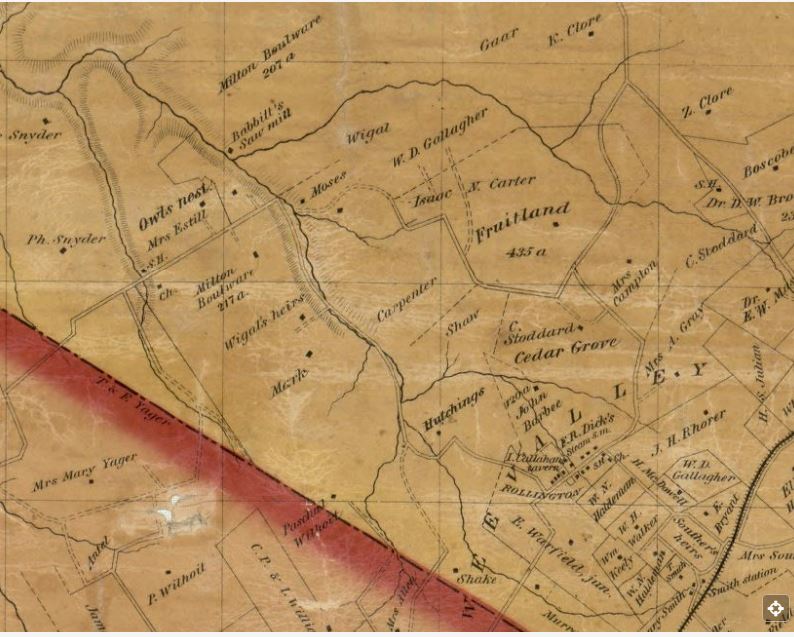
This portion of G.T. Bergmann's 1858 Map of Jefferson County shows Owl's Nest, the farm of Judge Benjamin Estill and his wife, Patsy. One of their daughters, Corrinna, married Benjamin Casseday, the author of "History of Louisville" in 1852, and one of the residents purportedly involved in giving Pewee Valley its name. The Cassedays lived at Owl's Nest for a time. Many years later, Benjamin's crippled younger sister, Jennie Casseday, turned Beechmore into the Jennie Casseday Rest Cottage for Working Women.
|
Their son Nathaniel and his wife, Alice, remained in Pewee Valley the rest of their lives. For many of the years they were married, Alice's widowed mother, Patsy Estill, lived with them.
After Alice's marriage to Nat in May 1860, Mrs. Estill put Owl's Nest, the 283-acre farm she had owned with her late husband, up for sale. The young Warfields then built a home of their own on Nat's parents' Beechmore estate in Pewee Valley. Born in 1800, Patsy Estill lived to be 95 and witnessed many historic events during her long and interesting life in politics. In September 10, 1892, the Courier-Journal published a lengthy interview with her featuring her personal reminisences of John Quincy Adams, Henry Clay, Daniel Webster, Sam Houston, John Calhoun and other politicians she met while living in Washington, D.C. and growing up in Frankfort, Ky. Included in the interview was a word portrait of the scene around the Warfield dining room table in 1892: ...A pretty sight was witnessed at the Warfield home in Pewee Valley a few days ago. Around one table were the representatives of four generations engaged in pleasant conversation. To the left of Mrs. Warfield sat her mother, Mrs. Estill, who is in her ninety-third year. Opposite |
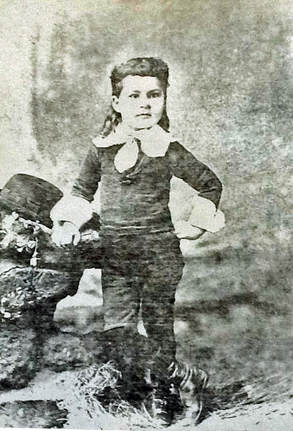 Thomas Quinton Munce, Jr., great-grandson of Patsy Estill and Catharine Warfield
Thomas Quinton Munce, Jr., great-grandson of Patsy Estill and Catharine Warfield
Mrs. Estill was her granddaughter, Mrs. Capt. Munce. and near her sat her handsome little son, Thomas Quitman Munce, who if he attain the age of his grandmother, will witness the ushering in and out of the year 1977....
The interview also included Nat Warfield's impressions of his still-vigorous mother-in-law:
... Mr. Nat Warfield, Mrs. Estill's son-in-law, declares that she is the first one up and the last one to retire on the place, and that he has seen no difference in her appearance since he married her daughter, thirty years ago. Mrs. Estill paints in watercolors and has done exquisite fancy work, but she now prefers to use her eyes for reading and spare them at other times. She often takes the morning train and comes into the city, and there seems no reason to doubt that she may say: "Hail to the year 1900."
The interview also included Nat Warfield's impressions of his still-vigorous mother-in-law:
... Mr. Nat Warfield, Mrs. Estill's son-in-law, declares that she is the first one up and the last one to retire on the place, and that he has seen no difference in her appearance since he married her daughter, thirty years ago. Mrs. Estill paints in watercolors and has done exquisite fancy work, but she now prefers to use her eyes for reading and spare them at other times. She often takes the morning train and comes into the city, and there seems no reason to doubt that she may say: "Hail to the year 1900."
Photos of Capt. Thomas Quitman Munce, Husband of "Kitty" Warfield, and Later, Kitty's Niece "Stella," Courtesy of Brad Munce
|
Patsy Estill didn't live to see 100. She died on August 24, 1895 and her obituary ran in the August 26 Courier-Journal:
A REMARKABLE WOMAN ___________________________ Death of Mrs. Patsy Estill At Pewee Valley __________________________________ Noted for Her Personal Charm and Many Accomplish- ments. _________________________________ WAS BORN IN 1800 Mrs. Patsy Estill, widow of the late Judge Benjamin Estill, died Saturday at the residence of her daughter, Mrs. Nat Warfield, at Pewee Valley. She was ninety-five years of age on July 23, last. Mrs. Estill was one of the most remarkable women, as well as one of the most beautiful. Indeed, she was a noted woman. She sprang from a family numbered among the original settlers of Kentucky, and in her manner she at once impressed one with her nobility of birth and character. She was Miss Patty Hickman, daughter of a pioneer killed in Franklin county who was killed on a battlefield. She was reared in Franklin County and in her youth cultivated her talents and developed the qualities that made her such an extraordinary woman. She was highly educated and among her accomplishments were painting and embroidery. Only a few years ago she painted a picture which she presented to a friend. She was also a brilliant conversationalist and in her ballroom days she was a belle. She was married to Judge Benjamin Estill, who was a United States Judge in Abingdon, Va., where he ranked high as a jurist. For a while they lived in Washington. Here Mrs. Estill was one of the notable society women. At the christening of their oldest daughter, Corinna, Sir Charles Vaughn, the British minister, was the godfather. The gifts were so marked Mrs. Estill were retained in her old age. She was the oldest member of the Woman's Confederate Monument Association, all of whose members esteemed her highly. Four children were born to Judge and Mrs. Estill, of whom only one is living, in the person of Mrs. Nat Warfield. The others were Corinna, who was the wife of the late Benjamin Casseday; Susan, who married a Mr. Telondia, of France; and a son, who died in infancy. The funeral of Mrs. Estill will take place at 10:00 this morning from the Episcopal Church at Pewee Valley. |
|
Census records show Nathaniel was employed during his life as a real estate agent. He and Alice had three children:
- Florence Estill "Stella" (April 1863-1933) married her uncle, Thomas Quitman Munce (Oct. 1842-October 25, 1903), on December 17, 1885. Captain Munce was previously married to her Aunt Kitty.
- Nathaniel W., b. April 1869
- Estill, b. 1871
Their property, shown on the 1907 map of Pewee Valley, was located off two roads: Huston (later Houston) and Rest Cottage Lane, behind the Bondurant-Hustin House. Their eight-room home was auctioned off in 1925, 17 years after Nat's death and the year before his wife Alice died. Three years later, it was up for auction again. Both times, classified ads in the Courier-Journal offered excellent descriptions of the property.
Little Colonel Connections
The Warfields were friends with Annie Fellows Johnston, and although they didn't inspire any of the characters in her "Little Colonel" series, they inadvertently helped with "The Little Colonel's Hero." This letter, written to Mamie Lawton while Annie was living in Walton, New York with her ailing stepson John, tells how the idea for the story came about:
Walton, Delaware Co. New York
May 20, 1902
My Dear Mrs. Lawton--
For the last two weeks I have been struggling with "The Little Colonel's Hero" to the exclusion of everything else, and writing to all points of the compass for facts and figures. You will be interested in it, I know, being the lady who suggested it to me. Do you remember the day we dined at Mrs. Warfield's, when you crossed the room and showed me the picture of the Red Cross War dog? Well that is the Hero, only I have changed him from a collie to a magnificent St. Bernard.
The Little Colonel is to go abroad in this book. In Geneva she comes into possession of Hero, in a dramatic way, and there in that home of heroes and in the cradle of the Red Cross movement itself, she becomes acquainted with the history of the Association and all that it has accomplished for humanity in the times of flood, fever, famine and fire as well as war.
Today, Clara Barton sent me a pile of reports and histories and speeches concerning it, which will help me amazingly. I wanted to ask if you have ever met her, and if you have, if there was anything in your acquaintance which I might be given in this story to add a personal touch to this work. Also, did the nurses, ambulance corps, etc, in the Philippines work under the flag of the Red Cross? I have found nothing later in the reports than the Cuban war, but supposed they were at the front also in the Philippines.
From Switzerland, the Little Colonel goes to Tours and meets Betty and Eugenia at the Gate of the Giant Scissors. They all return to the Valley in the fall where they find the Waltons ensconced in their new home in the country. I should like to call it by name. What can you suggest? Maybe if you have found a name for your place, you would not object to my referring to it by its real name.
There will probably be a camping party near Bashes which you chaperone, and I am thinking of having a state encampment near there at the same time where a sham battle is fought and Hero shows his training. Have not fully decided that. Of course he saves somebody on several occasions through the story. I think he will have to die in the end however to be artistic -- maybe while the encampment is still there so that they may fire a salute over him. Then wouldn't it be all right for a noble war dog who had done his duty as bravely as a man and lost his life in the saving of a life to have "taps" sounded over his resting place by The Little Captain? or ought that to be reserved only for human heroes? Any suggestions or criticisms will be most thankfully received.
With love to you and all yours
Affectionately
Annie Fellows Johnston
Death and Burial
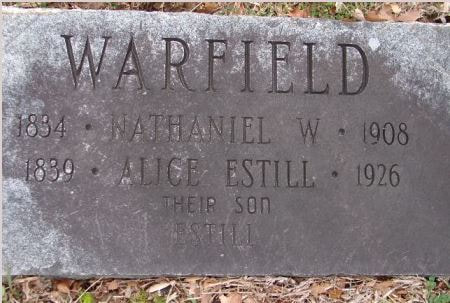 Headstone for Nathaniel and Alice Warfield, and their son, Estill, at Pewee Valley Cemetery.
Headstone for Nathaniel and Alice Warfield, and their son, Estill, at Pewee Valley Cemetery.
Nathaniel died in 1908. His obituary was published in the December 16, 1908 Courier-Journal:
WARFIELD --Nathaniel W. Warfield, Sr., in the 75th year of his age.
Burial from the Episcopal Church, Pewee Valley, at 3 p.m. Dec. 16. Take L and N train, Tenth and Broadway, at 2 p.m., or L and E electric at 1:30.
St. Louis, Denver and Lexington papers please copy.
Alice died in 1926. By that time, she was no longer living in Pewee Valley. A short obituary ran in the April 26, 1926 Courier-Journal:
WARFIELD -- Mrs. Alice E., widow of N.W. Warfield, Sr., in her 86th year at Kentucky Baptist Hospital on Sunday, April 18. Funeral from St. Andrews Church Monday at 2 o'clock. Interment at Pewee Valley.
Alice, Nathaniel and their youngest child, Estill, are buried in Pewee Valley Cemetery.
Related Links

